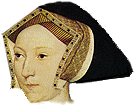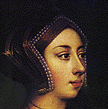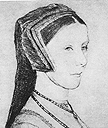
English Gable Hood
The most notable type of headwear worn by well-to-do and better off Englishwomen during the first decades of the 16th century was an item now referred to as an English hood or Gable Hood. Complex and bulky, and peculiar to England and Flanders, its interior construction is even now a mystery.
 The first intimations of this emerging Tudor style can be seen in the picture of Margaret Beaufort shown to the right, painted in 1503. She is wearing a long veil, a common style of headwear for the time, but the front section is heavily starched and stiffened into a point.
The first intimations of this emerging Tudor style can be seen in the picture of Margaret Beaufort shown to the right, painted in 1503. She is wearing a long veil, a common style of headwear for the time, but the front section is heavily starched and stiffened into a point.
 This portrait of Catherine of Aragon, Henry VIII's queen, was painted around 1518. She is wearing what will become the classic "gable hood"-and as you can see, the silhouette of her headwear is quite similar to that of Lady Beaufort above. It has become much more decorative and complex,
however; the starched front section of her veil is clearly wired and stiffened, and has a jeweled "billiment" along the front. The long sections on either side, known as "lappets" are also jeweled and embroidered; and two strips of fabric have been sewn inside the top front of the hood to hide the hair.
This portrait of Catherine of Aragon, Henry VIII's queen, was painted around 1518. She is wearing what will become the classic "gable hood"-and as you can see, the silhouette of her headwear is quite similar to that of Lady Beaufort above. It has become much more decorative and complex,
however; the starched front section of her veil is clearly wired and stiffened, and has a jeweled "billiment" along the front. The long sections on either side, known as "lappets" are also jeweled and embroidered; and two strips of fabric have been sewn inside the top front of the hood to hide the hair.
 For the next decade and well into the 1540s, the structure of the gable hood did not change significantly from the headdress worn by Queen Katharine.
The jeweled billiments vary widely in design and color, as does the embroidery of the lappets and the stylish pinning , shaping and draping of the bulky hood fabric in the back, but the construction and shape of the English hood remains consistant throughout.
For the next decade and well into the 1540s, the structure of the gable hood did not change significantly from the headdress worn by Queen Katharine.
The jeweled billiments vary widely in design and color, as does the embroidery of the lappets and the stylish pinning , shaping and draping of the bulky hood fabric in the back, but the construction and shape of the English hood remains consistant throughout.

 As the 1530s progressed, the sides of the English Hood became shorter. The billiments ended above the jaw, rather than at the chin line, and the side lappets and veil
were pinned up. Several sketches of women wearing these hoods were drawn by Hans Holbein the Younger in the 1530s, two of which are shown to the left and the right. All of the portraits show women wearing hoods exceedingly similar in design; some have decorative, jeweled billiments along the front edge, while others do not. The gable hood was the fashionable headwear in the court of king Henry VIII until the 1540s.
As the 1530s progressed, the sides of the English Hood became shorter. The billiments ended above the jaw, rather than at the chin line, and the side lappets and veil
were pinned up. Several sketches of women wearing these hoods were drawn by Hans Holbein the Younger in the 1530s, two of which are shown to the left and the right. All of the portraits show women wearing hoods exceedingly similar in design; some have decorative, jeweled billiments along the front edge, while others do not. The gable hood was the fashionable headwear in the court of king Henry VIII until the 1540s.
A new, lighter form of headwear began to make an appearance in the 1530s. Worn mostly by younger women, this hood combined the square shape of the gable hood with the flatter, less bulky silhouette of the emerging french hood.
 Anne Cresacre is shown to the right wearing such a hood, which can be called a "transitional" english hood for lack of a better word. It lays flat across the top and bends down at the sides, creating a square profile much like that of the holbein sketch of Anne Boleyn in a coif. Indeed, it is entirely probable that coif and hood were worn in conjunction with eachother-the edging of lace appearing underneath Anne's hood could be the edge of her coif. A veil pinned over the hood fell down the back.
Anne Cresacre is shown to the right wearing such a hood, which can be called a "transitional" english hood for lack of a better word. It lays flat across the top and bends down at the sides, creating a square profile much like that of the holbein sketch of Anne Boleyn in a coif. Indeed, it is entirely probable that coif and hood were worn in conjunction with eachother-the edging of lace appearing underneath Anne's hood could be the edge of her coif. A veil pinned over the hood fell down the back.
This style of hood coexisted with the older gable variety; the More family sketch, created in 1528, provides a snapshot of women of different ages wearing different headwear. In actuality, this square-shaped hood had much in common with the newly emerging fashion that was soon to replace the gable hood: the French Hood.
Constructing a Gable Hood
Home
 The first intimations of this emerging Tudor style can be seen in the picture of Margaret Beaufort shown to the right, painted in 1503. She is wearing a long veil, a common style of headwear for the time, but the front section is heavily starched and stiffened into a point.
The first intimations of this emerging Tudor style can be seen in the picture of Margaret Beaufort shown to the right, painted in 1503. She is wearing a long veil, a common style of headwear for the time, but the front section is heavily starched and stiffened into a point.
 This portrait of Catherine of Aragon, Henry VIII's queen, was painted around 1518. She is wearing what will become the classic "gable hood"-and as you can see, the silhouette of her headwear is quite similar to that of Lady Beaufort above. It has become much more decorative and complex,
however; the starched front section of her veil is clearly wired and stiffened, and has a jeweled "billiment" along the front. The long sections on either side, known as "lappets" are also jeweled and embroidered; and two strips of fabric have been sewn inside the top front of the hood to hide the hair.
This portrait of Catherine of Aragon, Henry VIII's queen, was painted around 1518. She is wearing what will become the classic "gable hood"-and as you can see, the silhouette of her headwear is quite similar to that of Lady Beaufort above. It has become much more decorative and complex,
however; the starched front section of her veil is clearly wired and stiffened, and has a jeweled "billiment" along the front. The long sections on either side, known as "lappets" are also jeweled and embroidered; and two strips of fabric have been sewn inside the top front of the hood to hide the hair.
 For the next decade and well into the 1540s, the structure of the gable hood did not change significantly from the headdress worn by Queen Katharine.
The jeweled billiments vary widely in design and color, as does the embroidery of the lappets and the stylish pinning , shaping and draping of the bulky hood fabric in the back, but the construction and shape of the English hood remains consistant throughout.
For the next decade and well into the 1540s, the structure of the gable hood did not change significantly from the headdress worn by Queen Katharine.
The jeweled billiments vary widely in design and color, as does the embroidery of the lappets and the stylish pinning , shaping and draping of the bulky hood fabric in the back, but the construction and shape of the English hood remains consistant throughout.

 As the 1530s progressed, the sides of the English Hood became shorter. The billiments ended above the jaw, rather than at the chin line, and the side lappets and veil
were pinned up. Several sketches of women wearing these hoods were drawn by Hans Holbein the Younger in the 1530s, two of which are shown to the left and the right. All of the portraits show women wearing hoods exceedingly similar in design; some have decorative, jeweled billiments along the front edge, while others do not. The gable hood was the fashionable headwear in the court of king Henry VIII until the 1540s.
As the 1530s progressed, the sides of the English Hood became shorter. The billiments ended above the jaw, rather than at the chin line, and the side lappets and veil
were pinned up. Several sketches of women wearing these hoods were drawn by Hans Holbein the Younger in the 1530s, two of which are shown to the left and the right. All of the portraits show women wearing hoods exceedingly similar in design; some have decorative, jeweled billiments along the front edge, while others do not. The gable hood was the fashionable headwear in the court of king Henry VIII until the 1540s.
 Anne Cresacre is shown to the right wearing such a hood, which can be called a "transitional" english hood for lack of a better word. It lays flat across the top and bends down at the sides, creating a square profile much like that of the
Anne Cresacre is shown to the right wearing such a hood, which can be called a "transitional" english hood for lack of a better word. It lays flat across the top and bends down at the sides, creating a square profile much like that of the